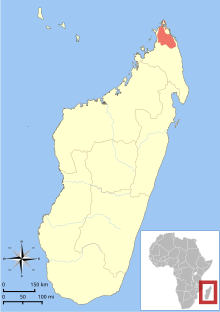Crowned tarsier
| Crowned tarsier | ||||||||||||
|---|---|---|---|---|---|---|---|---|---|---|---|---|

Crowned Lemur ( Eulemur coronatus ), male |
||||||||||||
| Systematics | ||||||||||||
|
||||||||||||
| Scientific name | ||||||||||||
| Eulemur coronatus | ||||||||||||
| ( Gray , 1842) |
The crowned lemur ( Eulemur coronatus ) is a species of primate from the family of common Makis (Lemuridae) within the lemurs (Lemuriformes).
features
Crowned lemurs are among the smaller representatives of the common lemurs. They reach a head body length of 34 to 36 centimeters, the tail is significantly longer with 41 to 49 centimeters. The weight is 1.5 to 1.8 kilograms. The sexes differ in the color of their fur. The males are gray-brown on the upper side and white-gray on the belly. The long, bushy tail is slightly longer than the body. The face is light gray, the tip of the elongated snout is black. It is characterized by the orange V-shaped pattern on the head, which frames the top of the head, which is colored black. The cheeks are also provided with orange, bushy hair. The females are a little more inconspicuous in color: their fur is gray on the back and white-gray on the belly. The top of the head, framed by the V-shaped drawing, is gray and not black, and the orange hair on the cheek is missing.
Distribution and way of life
Crowned lemurs are native to the northern tip of the island of Madagascar . As a habitat they prefer dry and semi-arid deciduous forests, but they also occur in more humid forest forms. They are cathemeral , that is, they do not have a distinct day-night rhythm and can be active both day and night. They live in groups of mostly 5 to 6 animals (sometimes up to 15) animals, which are divided into subgroups of 2 to 4 animals when searching for food, while they keep in contact with grunts. One group lives in an area of 10 to 15 hectares, which overlaps extensively with the areas of other groups.
The sense of smell plays an important role in communication, and they also communicate with postures (such as sticking out the tongue as a greeting) and sounds.
When foraging for food, they tend to stay in the lower tree layers, thereby avoiding food competition with the sympatric Sanford Maki ( Eulemur sanfordi ). They primarily eat fruits , in the dry season also young leaves and insects, in the rainy season, however, various plant material.
Reproduction
The mating takes place in May or June, after a gestation period of around 125 days, the female gives birth to one or two young in September or October. After around five months, the boy is weaned and sexually mature at around 20 months.
Danger
The main threat to the crowned lemur is the destruction of its habitat by slash and burn , charcoal production and mining. Its distribution area covers less than 20,000 km², is severely fragmented and in decline. In the Red List of the IUCN , the species as is ( "high risk" Endangered ) out.
The only German zoos in which black lemurs are kept are Leipzig, Dresden, Rheine and Erfurt. In Europe, crowned lemurs can still be seen in France, the Netherlands, the Czech Republic and Great Britain.
literature
- Nick Garbutt: Mammals of Madagascar. A Complete Guide. Yale University Press, New Haven CT et al. 2007, ISBN 978-0-300-12550-4 .
- Thomas Geissmann : Comparative Primatology. Springer-Verlag, Berlin et al. 2002, ISBN 3-540-43645-6 .
Individual evidence
Web links
- Photos, videos and information at arkive.org
- Information at Animal Diversity Web
- Eulemur coronatus onthe IUCN Red List of Threatened Species . Retrieved March 25, 2009.

